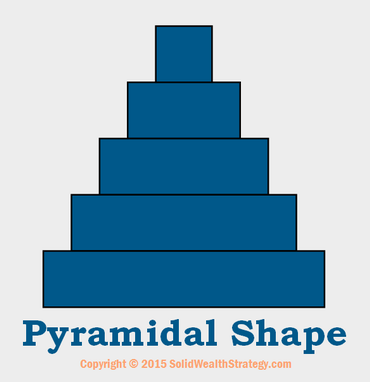esign process entails shaping the way we respond to price changes in the market. Depending on the market, investing instrument and few other considerations, we determine the shape we expect to produce the best results. We use several different shapes, or “solids” as we sometimes call them. However the most common shape that gives the best returns in most circumstances is the shape that resembles a pyramid.
 T
T
here are number of reasons why our most prominent solid is a pyramid. The most obvious reason stems from graphical or geometrical resemblance. Pyramids represent strategy’s foundational principle of increased response based on price relativity. We even call that principle “pyramiding”.
The principle of pyramiding in Solid Wealth Strategy assumes increase in response amount as the price of selected investment instrument continues moving in a certain direction. Response in this context is either buying or selling.
The increase in amount bought or sold can graphically be represented as a stack of blocks where blocks that correspond to larger amounts have larger widths too. With little imagination, this stack of blocks (or our market orders) looks like a pyramid. So it was only natural to name the whole process Pyramiding!
gyptian pyramids are ancient world wonders that probably amaze many with their beauty, stability and longevity. They carry a strong symbolism to monumental achievements of early civilizations. In a sense, Solid Wealth Strategy carries similar charisma in the world of investing. It gives your portfolio stability, longevity to your investing success and provides you with monumental achievement in terms of consistent profitability.
Thus, not only pyramiding makes a lot of sense in terms of geometry of Solid Wealth Strategy, but pyramids also have similar figurative meaning or symbolism for the strategy itself.
In the process of designing pyramidal shapes, we use many analogies: we refer to the height of pyramids or slant of their sides. In certain instances, top of pyramids may be clipped, which we call a base. Also sides may be step alike, and strategy heavily relies on concept of step as a difference between two adjacent price levels. We design and apply pyramids of all sizes, shapes and forms.
All in all, pyramids are amazing and they also seem to be an excellent match for this amazing strategy.





